The end of the Peasant War of Stepan Razin and the fate of the chieftains
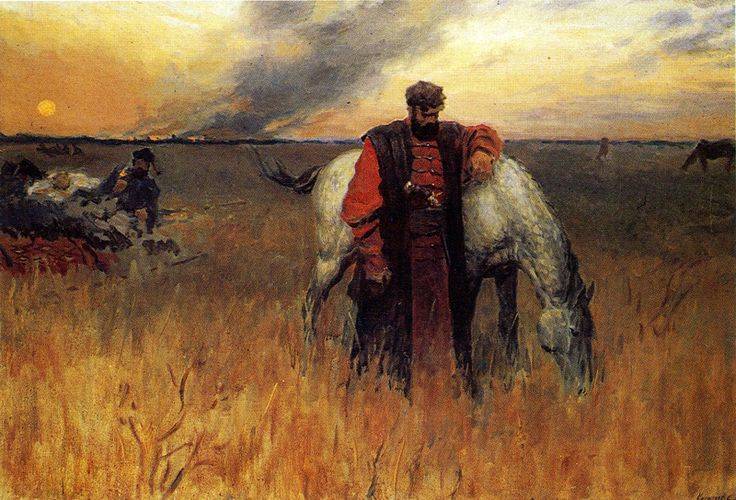
S. Kirillov. "At the Simbirsk line"
In the previous article (“Razinism. The beginning of the Peasant War) was told about the events of the turbulent 1670: the new campaign of Stepan Razin on the Volga, the first successes of the rebels, their defeat at Simbirsk. It was also mentioned that several detachments were sent by Razin to Penza, Saransk, Kozmodemyansk and some other cities.
"Field commanders" of the Peasant War
Of course, it is impossible to talk about all the "chieftains" of that time in one article. Let us try to briefly mention at least some of them. We have already talked about Vasily Usa and Fedor Sheludyak, and in the near future we will continue this story. In the meantime, a little about the other leaders of the rebel units of this Peasant War.
Mikhail Kharitonov, who came with Razin from the Don, took control of the vast territory between Sura and Volga, first capturing Yushansk, Tagan, Uren, Korsun, Sursk, and then Atemar, Insar, Saransk, Penza, Narovchat, Upper and Lower Lomovs. In the Penza region, he connected with detachments of other chieftains - Fedorov, Chirk and Shilov (there were rumors about Shilov that he was Stepan Razin, who was dressed in disguise). In Saransk Kharitonov managed to organize weapons workshops. Here are the “lovely letters” he sent around the district:
Kharitonov and Fedorov reached Shatsk (a city in the modern Ryazan region), but on October 17 they were driven back by detachments of Smolensk and Roslavl gentry, who were subjects of the Commonwealth even 15 years ago. Voivode Khitrovo wrote about this difficult and stubborn battle:
In November 1670, Kharitonov was defeated by the troops of Prince Yu. Baryatinsky, retreated to Penza, was captured and was executed in December of this year.
Vasily Fedorov, mentioned above, was either a Saratov archer, or a soldier of the Belgorod regiment, who fled to the Don, where he "lived in the Cossacks." The rebel Fedorov was chosen as the "city chieftain" of Saratov. He was also captured and executed in December 1670.
Maxim Osipov, sent by Razin at the head of 30 Cossacks “with lovely letters to ride and take a freeman into the Cossacks”, in a short time gathered an entire army of 1500 people, armed with even guns. With this detachment, Osipov in late spring 1671 went to the rescue of Fedor Sheludyak, whose troops attacked Simbirsk, but were late. However, the appearance of Osipov caused great fright in Simbirsk, where his detachment was mistaken for a new army of rebels. With the 300 warriors remaining with him, he finally made his way to Tsaritsyn, but by that time this city was no longer controlled by the Razinets and Osipov’s detachment was completely defeated. This happened in late July - early August 1671.
Ataman Akay Bolyaev, also known as Murzakayko, operated in eastern Mordovia, the size of his detachment reached 15 thousand people. Prince Baryatinsky describes the battle with the Bolyaev rebels at the Ust-Uren settlement as a big and difficult battle:
The rebels were defeated, Bolyaev was wounded, but a month later he again fought at the villages of Baevo and Turgenevo (December 7 and 8, 1670), was defeated and tried to hide in his native village of Kostyashevo (about 17 km from Saransk). Here he was extradited by fellow countrymen to the royal punishers and in December 1670 was quartered in Krasnaya Sloboda.
In the territory of Chuvashia there was a detachment of Izylbay Kabaev, in which "there were Russians, and Tatars, and a Chuvash with 3000 people." At the end of December 1670, he, together with the “Russian chieftains” Vasilyev and Bespaly, attacked the convoy of the governor Prince Baryatinsky, but was defeated at the village of Dosayevo, was captured and executed.
Ilya Ponomarev, who is also mentioned under the names of Ivanov, Popov and Dolgopolov, was a native of the city of Kad and a Mari by nationality. A description of his appearance has been preserved: "The height of the average person, the hair is light-colored, in the face is oblong, the nose is straight, oblong, the beard is small, with small blacker hairs."
With a "lovely letter" by Stepan Razin, he was seized in Kozmodemyansk district and sent to prison. But already on October 3, 1670, the inhabitants of Kozmodemyansk opened the gates to a small detachment of Razintsy (30 people), Ponomarev was released and elected ataman. After the failure of Tsivilsk, he took his detachment to Vetluzhsky volost, where the city of Unzha was taken. The frightened Solikamsk governor I. Monastyrev reported to Moscow that he “has no one to defend himself ... to be dangerous and scary.”
Ponomarev was also captured and hanged in Totma in terrible for the rebels in December 1670.
Alena Arzamasskaya (Temnikovskaya)
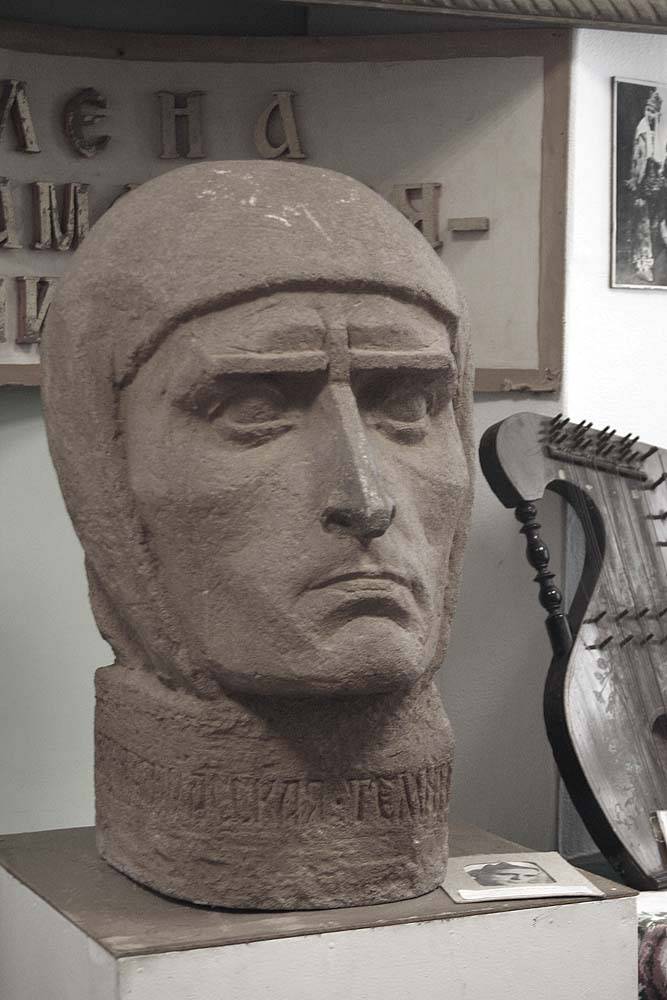
N. M. Obukhov. "Alena Arzamasskaya-Temnikovskaya." Reinforced concrete. 1971. Museum of Local Lore. Temnikov
Among the commanders of the rebels there was also one woman - a certain Alena, a native of the exit settlement (near Arzamas). Widowed, she went to the monastery, where she soon became known as a herbalist. Having learned about the Razin uprising, she managed to attract over 200 neighboring peasants to her side, whom she led to the Oka - initially to Kasimov, but then turned to Temnikov. Already 600 people came to this city with her.
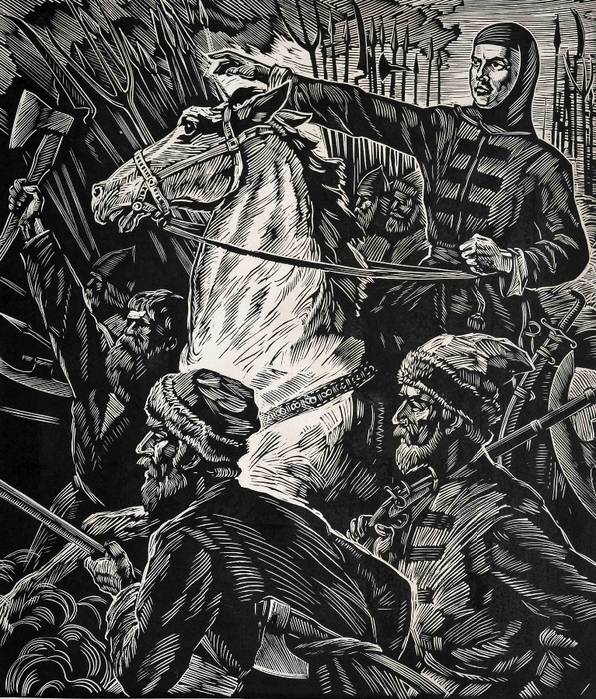
Here her detachment connected with other rebel units. The chief chieftain was Fedor Sidorov, who in September 1670 was freed by differences from the Saransk prison.
Anonymous foreign author in the “Report on the details of the rebellion carried out in Moscow by Stenka Razin” reports that a seven-thousand army gathered under the command of Alena and Sidorov.
The boyar son M. Vedenyapin in a report dated November 28, 1670 wrote at all:
But modern researchers believe that the total number of rebels was unlikely to exceed 5 thousand people. Their combined forces defeated the detachment of the governor of Arzamas, Leonty Shansukov.
In December 1670, Temnikovsky rebels were defeated, Sidorov managed to hide in the surrounding forests, and those remaining in the city, including Alena, were given to governor Yu.A. Dolgoruky. The executioners Alena was shocked by the fact that she silently endured all the tortures, on the basis of which it was concluded that she was a witch who did not feel pain. The author already mentioned by us, "Messages regarding the details of the rebellion ..." wrote:
This "Message ..." in 1671 was published in the Netherlands and Germany, and in 1672 in England and France, so in Europe they learned about this brave woman earlier than in Russia.
A certain Johann Frisch also wrote about Alena:
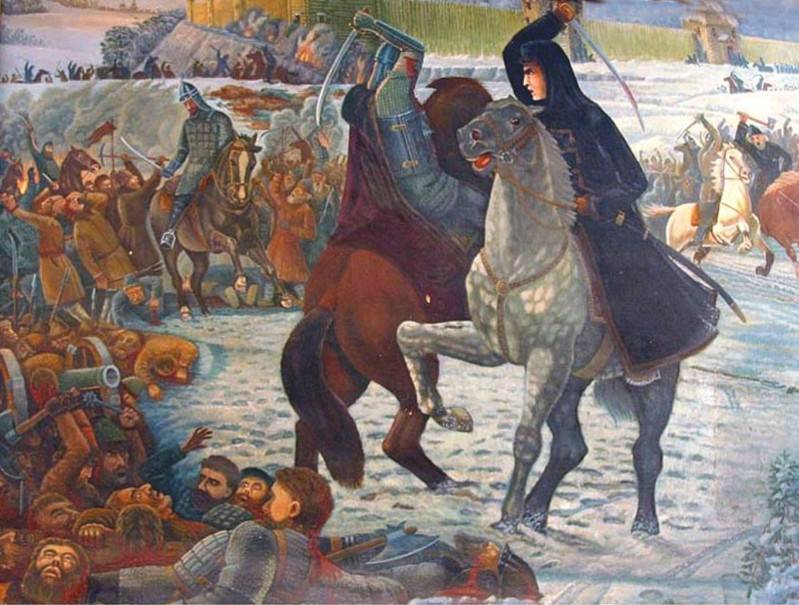
K. Smirnov. "The Fight of Alena of Arzamas"
Continuation of the Peasant War
The emissaries of Razin also revolted the peasants near Efremov, Novosilsk, Tula, and Borovsk, Kashira, Yuryev-Polsky rebelled without their participation. From October to December 1670, a five-thousand detachment of neighboring peasants, led by ataman Meshcheryakov, besieged and stormed Tambov twice. But the rebels left without a leader were defeated in the Volga region, in the Tambov region and in Slobozhanshchina (Sloboda Ukraine).
Returning to the Don was probably a fatal mistake of Stepan Razin: he had nothing to do there, almost all the Cossacks sympathizing with him were already in his army, and the elders and “domovites” were not enthusiastic about the return of the rebel chieftain, fearing the punitive expedition of the Moscow troops. In Astrakhan, however, nothing threatened Razin, and his name alone would attract thousands of people ready to fight under his command.
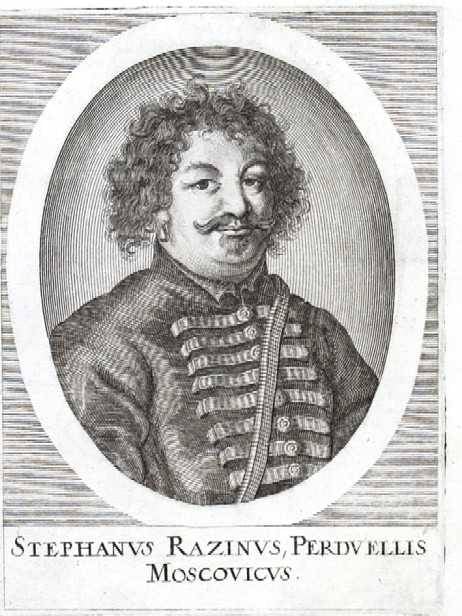
Portrait of Stepan Razin. Engraving by an unknown author, XVII century
But Razin was not going to give up. When Vasily Us asked him what to do with the treasury kept by him, the ataman replied that he would come to Astrakhan in the spring, and ordered the construction of the plows “more than before”. At that time, detachments from Astrakhan, Krasniy Yar, Black Yar, Saratov, Samara and other cities arrived in Tsaritsyn — about 8 thousand people gathered in 370 plows. With the Astrakhan people Fyodor Sheludyak came there, who was chosen as ataman in Tsaritsyno.
Betrayal
It is difficult to say how events would develop further if the dominant Cossacks, led by the military chieftain Korney Yakovlev (godfather of Stepan Razin) did not storm Kagalnik, where the chieftain was located. At the end of April 1671, the leader of the rebels was captured and given to the tsarist authorities.
Until 1979, on the wall of the Resurrection Cathedral in the village of Starocherkasskaya, one could see the chains with which, according to legend, Kornila Yakovlev fettered the captured godfather - Stepan Razin. They were stolen during the reconstruction and are now replaced by duplicates:
In the same cathedral there is the grave of Kornila Yakovlev.
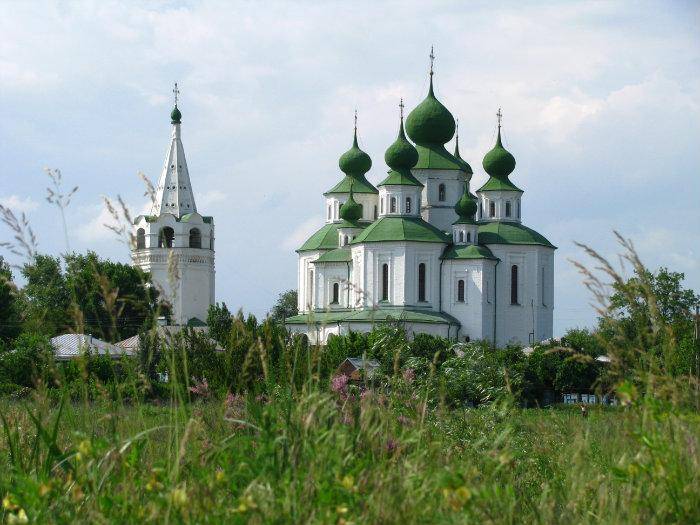
Resurrection Military Cathedral, the village of Starocherkasskaya
The traitors paid them thirty pieces of silver - a “special salary” in the amount of three thousand silver rubles, four thousand quarters of bread, 200 buckets of wine, 150 pounds of gunpowder and lead.
Stepan Razin and his brother Frol were brought to Moscow on June 2, 1671. According to the testimony of an Englishman who remained unknown, about a mile from the city of rebels, a prepared cart with a gallows met on which the chieftain was placed:
The investigation was short-lived: continuous torture lasted 4 days, but Stepan Razin was silent, and on June 6, 1671 he and his brother were sentenced: "Execute with evil death - to quart."
Since the ataman was already excommunicated and anathematized by Patriarch Joseph, he was denied a confession before his execution.
Thomas Hebdon - a representative of the British Russian company, who became an eyewitness to the execution, sent a message about it to the Hamburg newspaper "Northern Mercury":
“You know that we started such a thing that even with even greater success we could not expect a better end.”
Stop the quote to see Hebdon's drawing:
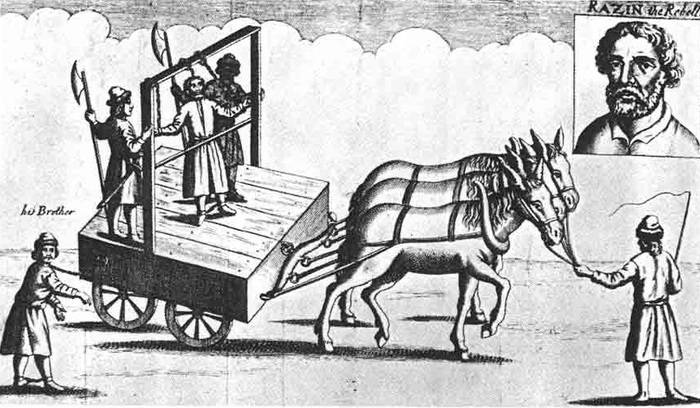
And below is a shot from the Soviet film "Stepan Razin", shot in 1939:
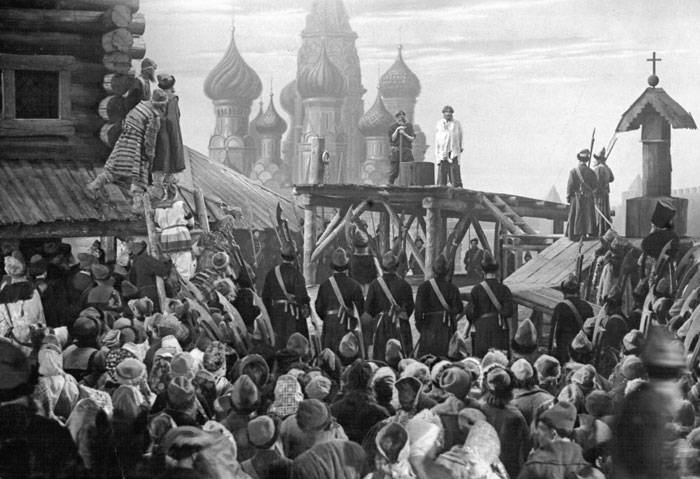
Continuation of the quote:
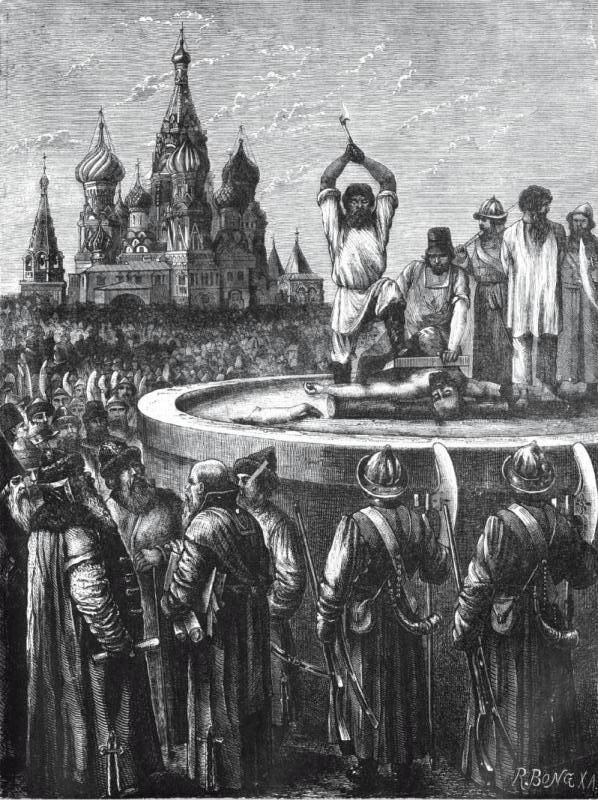
"The execution of Stepan Razin." Engraving by R. Bong according to a drawing by Medvedev
Stepan Razin was quartered at Frontal Place, and his brother Frol extended his torment for several years, shouting “the word and deed of the Sovereign” from the scaffold.
Razin, according to Marzius,
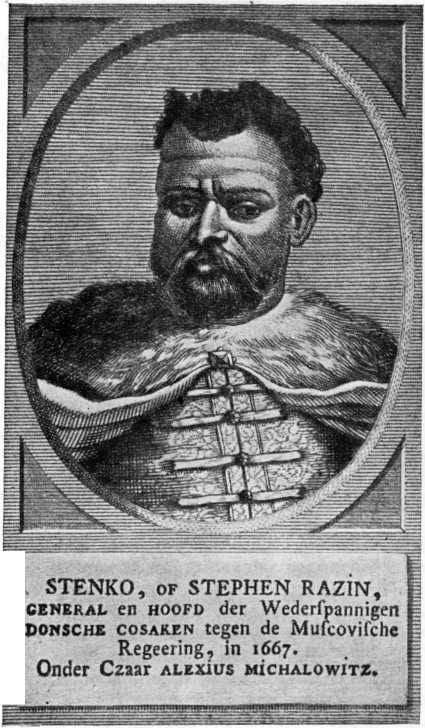
Portrait of Stepan Razin. From Becker Engraving

Cliff of Stepan Razin (Datura Mountain), Saratov Region, height 186 meters. In 1870, A. Navrotsky dedicated a poem to him, which after 26 years was put to music (“There is a cliff on the Volga”). Nearby peasants (including German colonists) claimed that they often saw here the ghost of the executed Stepan Razin
Stepan Razin was excommunicated, and therefore, according to some reports, his remains were later buried in the Muslim (Tatar) cemetery (outside the Kaluga Gate).
Frol Razin promised to give the authorities "thieves 'treasures" and "thieves' letters" hidden in a tarred jug, but neither the mysterious jug nor the treasures were found. About his execution, which took place on Bolotnaya Square on May 26, 1676, the Secretary of the Netherlands Embassy Balthazar Koyet reported:
On the same day as Stepan Razin (June 6, 1671), “a young man whom the chieftain passed off as the elder prince (Aleksei Alekseevich)” was executed at Lobnoye Ploshad, as described in a previous article. His real name remained unknown: he did not name him even under the most cruel tortures.
It has been suggested that under this name Ataman Maxim Osipov (mentioned at the beginning of the article) or the Kabardian prince Andrei Cherkassky who was captured by the Razin could be hiding. However, it is known for certain that Osipov was captured only in July 1671 - a month after the execution of False Alexei. As for Andrei Cherkassky, he remained alive and after the suppression of the uprising continued to serve Alexei Mikhailovich.
It is curious that at the end of the reign of Alexei Mikhailovich appeared False Simeon (posing as another son of this ruler from Maria Miloslavskaya, who was 12 years younger than Tsarevich Alexei). He "appeared" with the Cossacks, it is believed that this impostor was a certain Warsaw tradesman Matyushka.
Campaign of Fedor Sheludyak
Before the execution, Stepan Razin proudly declared to the whole people (and the authorities collected about a hundred thousand people):
These words were heard and spread throughout Russia.
Already after the uprising was suppressed in the city of Pronsk, one of the artisans heard from a soldier Larion Panin that “the thief and traitor Stepan Razin and his thieves' rabble had been beaten and his de, Stenka, had been wounded,” said: “Where can you beat Stenka Razin!”
Panin reported to him the governor, and these seditious words scared the local authorities so much that the case was investigated in Moscow, where the verdict was pronounced:
“The great sovereign pointed out, and the boyars sentenced peasant Eropkin Simoshka Bessonov to punish him for such words: beat him mercilessly, but he had to cut his tongue so that henceforth it wouldn’t be different to speak such words.”
And the comrades-in-arms of the rebellious ataman really continued the struggle after his arrest and death. They still controlled the Lower Volga region, and in the spring of 1671 Fedor Sheludyak again led the rebels to Simbirsk. On June 9 (after three days of the execution of Razin) this city was besieged, but it was not possible to take it. Having suffered heavy losses during two assaults, which were led by the ataman Fedor Sveshnikov and Tsaritsyn resident Ivan Bylinin, the rebels withdrew. In addition, news came of a serious illness, and then of the death of Vasily Usa, who remained in Astrakhan. This chieftain was buried with all sorts of honors, in all the Astrakhan churches a memorial service was served for him. For the rebels this was a very heavy loss, since Vasily Us was the second person in their midst after Razin, and even European newspapers reported on his death (for example, “Dutch Newsletters” - “Chimes”). A few days before his death, Metropolitan Joseph and governor S. Lvov, captured in 1670 near the Black Yar, were accused of relations with the Moscow authorities and Don foremen, which they issued to the authorities of Stepan Razin. Until that time, one and the other, according to Fabrizius, were not subjected to special harassment and even received their share in the division of “Duvan” - along with all the inhabitants of the city: “Even the Metropolitan, General and Voivode should have taken their share of the spoils”.
As for Simbirsk, in 1672 for the “double brave defense” from the troops of Razin and Sheludyak this city was granted a coat of arms depicting a lion standing on three paws with its tongue sticking out, a sword in his left paw, a three-petal crown over his head.
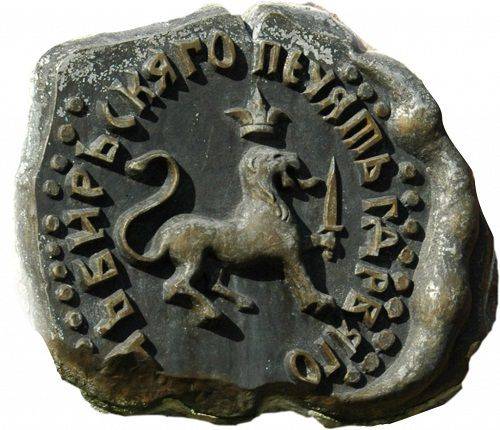
The first coat of arms of Simbirsk
Siege of Astrakhan by tsarist troops
Fyodor Sheludyak brought only two thousand people from Simbirsk to Tsaritsyn, but there was not enough food in this city, scurvy began, and therefore the ataman decided to leave for Astrakhan. It was he who led the resistance to the approaching tsarist troops (30 thousand people), which were led by the Simbir governor I. B. Miloslavsky (he defended this city during his siege by the army of Razin). The number of defenders of Astrakhan did not exceed 6 thousand people. Despite the obvious superiority in forces and the reinforcements received (detachments of Prince K.M. Cherkassky), the siege of this city lasted three months.
And on the Don at that time, many "malleable people" refused to "kiss the cross" on fidelity to the tsar.
Only after three days of unrest on the Cossack Circle in Cherkassk, Kornil Yakovlev managed to convince the Don Army to take the oath. But from the campaign to the rebellious Astrakhan, the Don people evaded, saying that they expect a raid of the Crimean Tatars.
Finally, Prince I. Miloslavsky, who led the troops besieging Astrakhan, made a solemn promise that, if surrendered, "not a single hair will fall from the citizens' heads."
On November 27, 1671, Astrakhan was surrendered, and, most striking, Miloslavsky kept his word. But the joy of the Astrakhan was premature: in July 1672, Prince Y. N. Odoevsky, the former head of the Detective Order, who did not take any oaths, was appointed city governor instead of Miloslavsky. Astrakhan by this time was completely pacified, there was no unrest and no reason for mass executions, but they followed - and immediately. One of the first was captured by Fyodor Sheludyak, who was hanged after long and cruel tortures.
The Dutch officer in the Russian service, Ludwig Fabrizius, who in no case can be "accused" of sympathy for the rebels, wrote about Odoevsky:
According to Fabricius, as a result of such official zeal Odoevsky in the city "there were only old women and small children."
If you believe the Dutchman (and there is no reason not to believe him in this case), it should be recognized that Astrakhan was completely ruined not by an external enemy and not rebels, but by a government official, and not in the process of suppressing the uprising, but several months after its completion. And this governor was far from the only sadist and a bloody maniac who surpassed in their cruelty even the atamans Stepan Razin, who were not even distinguished by special scrupulousness. In other places, the level of cruelty of the new bosses also “went off scale”.
The revenge of the authorities was truly terrible: for three months, royal punishers executed more than 11 thousand people. Others were beaten with whips; thousands of people had their tongues cut out or their hands chopped off.
Johann Justus Marcius, who defended his dissertation on the uprising of Stepan Razin in 1674 in Wittenberg:
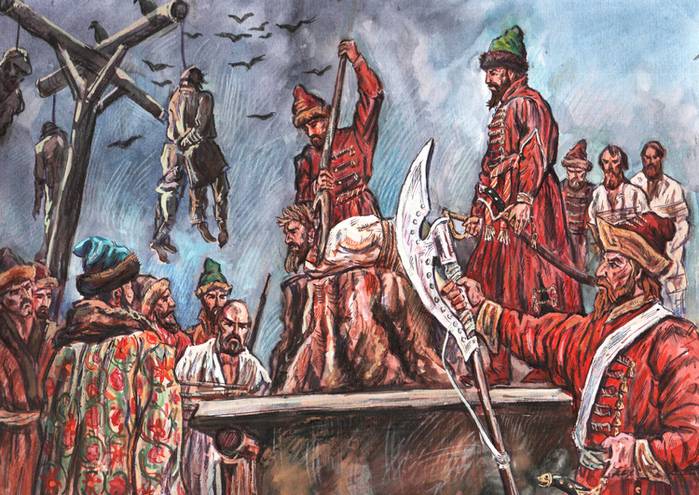
Leontiev O. “Reprisal against the rebels of Stepan Razin”
The appointment of Odoevsky and similar people as governors of the conquered regions, on the one hand, testifies to Alexei Mikhailovich’s fear of a new outburst of popular anger, and on the other hand, confirms the well-known thesis that he does not have the talent of a statesman: the tsar easily succumbed to external influences and could not calculate the long-term consequences decisions made. The fire of the Razin rebellion was literally filled with blood, but the memory of the atrocities of the tsar’s boyars and landowners, avenging their fear and humiliation, remained forever among the people. And when, after 100 years, Emelyan Pugachev “commanded” the nobles “to catch, execute and hang, and to act in the same way as they, without Christianity, repaired the peasants”, a new civil war, according to According to Pushkin, "shook Russia from Siberia to Moscow and from the Kuban to the Murom forests":
(A. S. Pushkin, “Remarks on the riot.”)
But back to Astrakhan: the deceived citizens tried to escape from the city then. Some made their way to Slobozhanshchina, others - to the Urals or even to Siberia. Some of them went north to the Old Believer Transfiguration Solovetsky Monastery: its rector Nikanor received everyone.
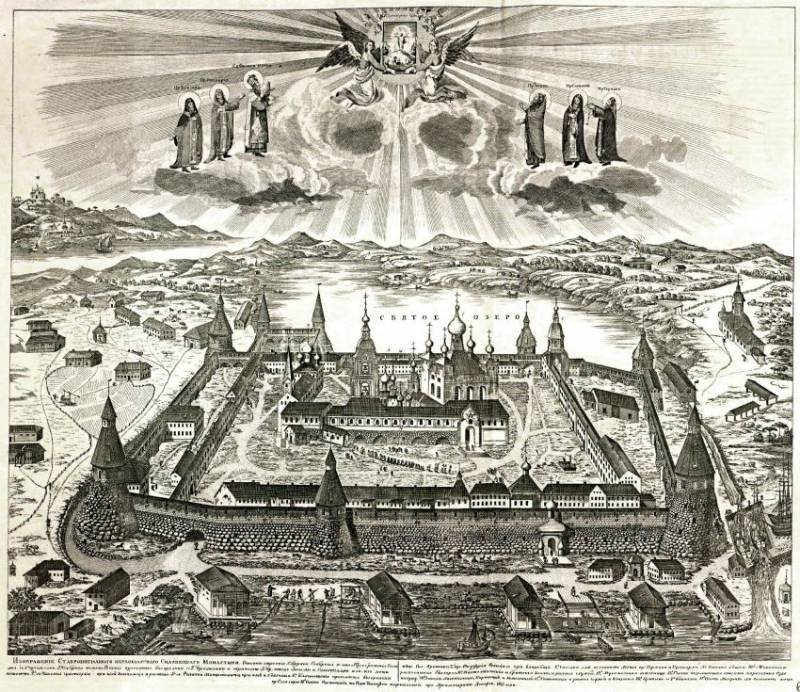
“View of the Solovetsky Monastery, printed from ancient planks stored in the sacristy there”, D. Rovinsky St. Petersburg, 1884
Here they died on January 22, 1676, after the black man Feoktist indicated a secret passage to the tsarist troops besieging the monastery. The massacre of the defenders of the monastery and its monks shocked even by no means sentimental foreign mercenaries, some of whom left memories of this amazing, which lasted from 1668 to 1676. the war of an entire state against one monastery.
The death of Tsar Alexei Mikhailovich
And Tsar Alexei Mikhailovich was dying at that time — painfully and terribly: “He was relaxed before death, and before that he was convicted, and we are tormented by endless torment.”
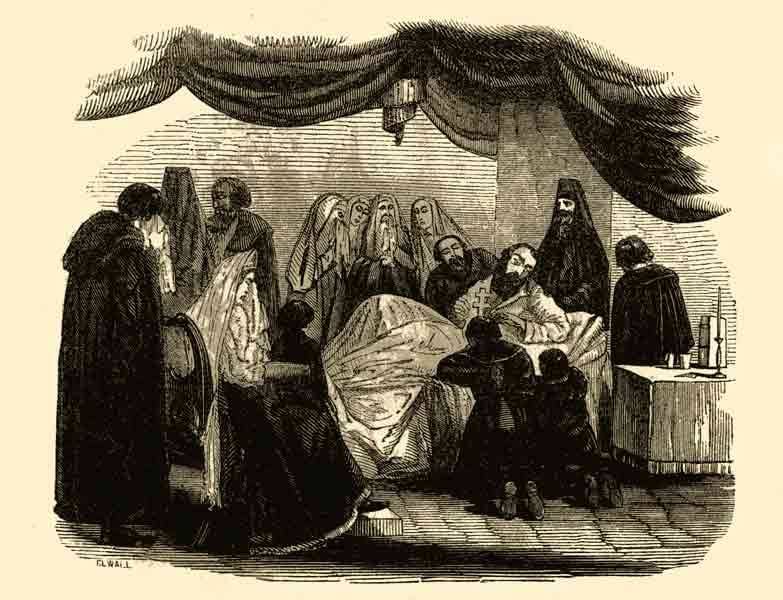
Elval. "The death of Tsar Alexei Mikhailovich on January 29, 1676." Engraving, early 1840s.
It seemed to the Tsar, who had organized cruel large-scale persecution of his compatriots who remained faithful to the former rites, it seemed that the Solovetsky monks rubbed his body with saws and he screamed screaming at the whole palace, imploring them:
He even sent an order to end the siege of the Solovetsky monastery, but the messenger was late for a week.
Alexei Mikhailovich Romanov died on January 29 (February 8), 1676, but the unrest of the peasants did not subside even after his death, breaking out in different parts of the state. They managed to eliminate their last foci only in the 1680s.
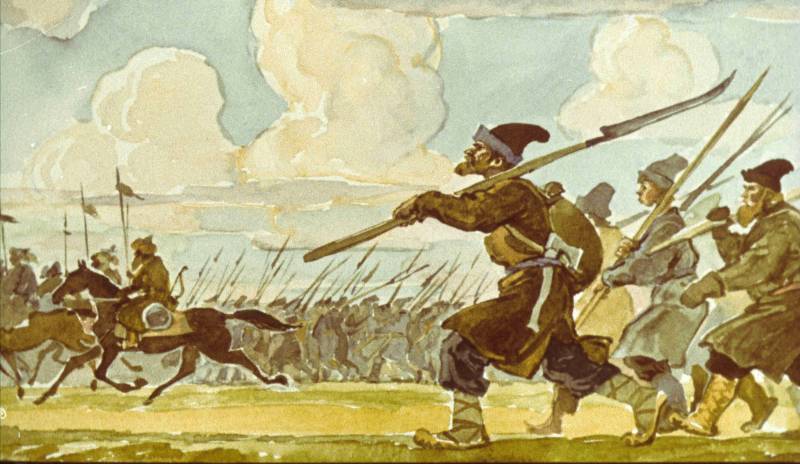
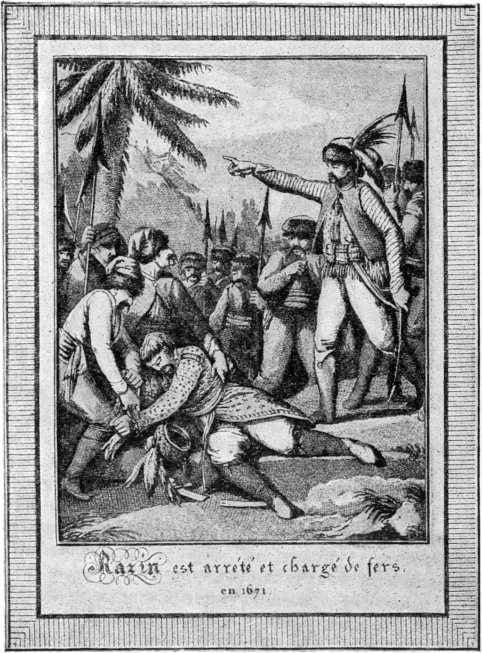
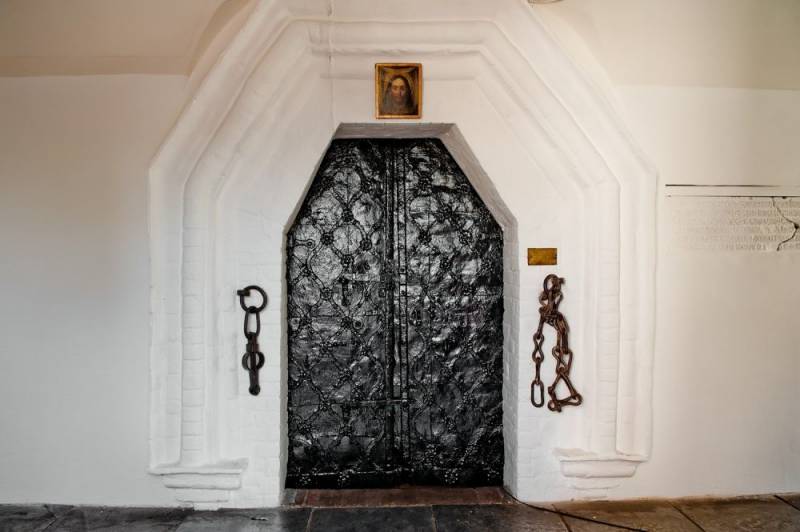
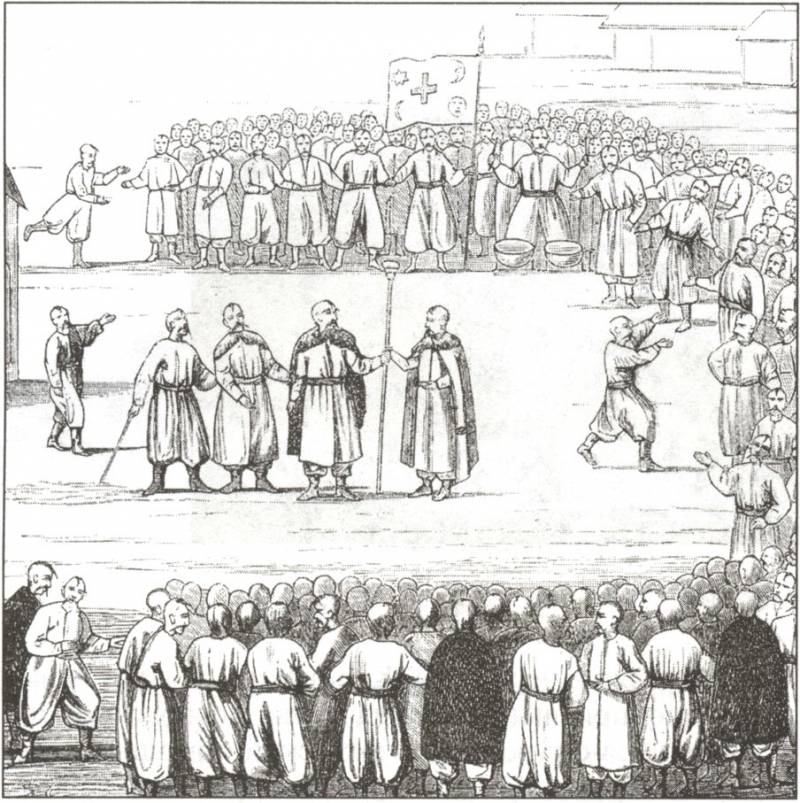
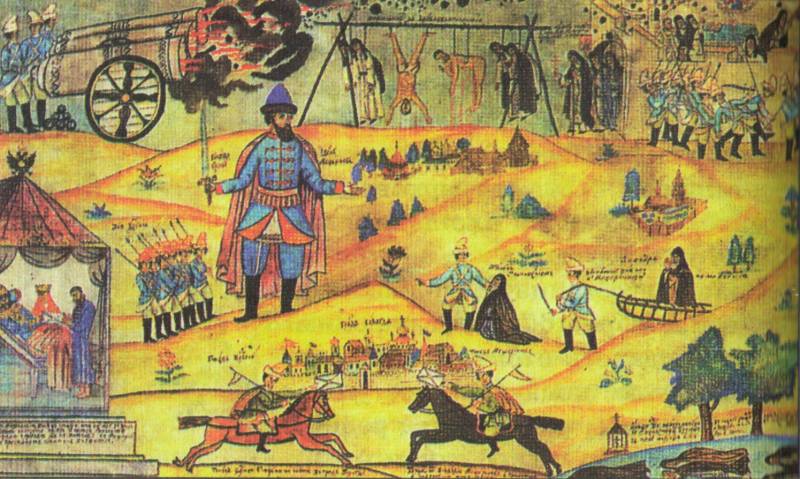
Information